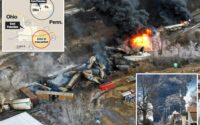Chinese spy balloon used US technology to surveil Americans
WASHINGTON – China used American technology in its spy balloon that snooped on US military bases earlier this year, a federal investigation analyzing the object’s debris has found.
Preliminary findings of the probe conducted by defense and intelligence agencies and the FBI and reported by the Wall Street Journal Thursday held that the balloon was carrying commercial products – some available online – as part of what President Biden described last week as “two boxcars full of spy equipment.”
The US gear was intermixed with “more specialized Chinese sensors and other equipment” with the purpose of snapping photos and capturing videos and other information to transmit to Beijing, according to the Journal.
Luckily for the US, the officials told the newspaper they did not believe the balloon was able to successfully transmit the data it collected back to Beijing. Though the report did not say why, it could be due to American military efforts to thwart the aircraft’s transmission ability with electromagnetic jamming, previously described by top brass.
The revelation comes nearly five months after the military retrieved the payload’s remnants from the Atlantic Ocean after the Air Force shot the spy device down off South Carolina’s coast on Feb. 4. The balloon had spent the previous eight days moving through US airspace from Alaska to the east coast, hovering over critical defense sites along the way.

Though China claimed the balloon was meant for weather monitoring, officials told the Wall Street Journal that the image and data-collecting payload supports the US’ presumption that the object was indeed a spy balloon.
The debris collected include scraps from a satellite-like object with sensors, solar panels that powered the craft, a propeller that allowed it to maneuver and loiter over sensitive sites for long periods, as well as a mix of other off-the-shelf and specially designed devices to capture imagery and radar data. It was unclear as of Thursday afternoon which specific items were American-made.
The news comes after the House Select Committee on the Chinese Communist Party sounded the alarm on China’s use of American products to spy on the US.

In a June 21 letter, committee chairman Rep. Mike Gallagher (R-Wis.) asked US Director of National Intelligence Avril Haines and Secretary of Commerce Gina Raimondo what they know about Beijing using American technology to surveil the US from a spy post in Cuba.
Six days later, the committee wrote Secretary of State Antony Blinken, urging him not to renew a US-China science and technology cooperation agreement that they say Beijing has put to nefarious use, employing advances against the US that were made with the help of the US.
“In 2018, the National Oceanic and Atmospheric Administration (NOAA) organized a project with China’s Meteorological Administration – under the STA – to launch instrumented balloons to study the atmosphere,” the letter read. “As you know, a few years later, the PRC used similar balloon technology to surveil US military sites on US territory – a clear violation of our sovereignty.”
When asked about the preliminary findings Thursday, Chinese Foreign Ministry spokeswoman Mao Ning clung to Beijing’s position that the craft was not sent to surveil the US, adding the she was “not aware of the sources of the report.”

“As China has stated on many occasions, the unmanned Chinese civilian airship drifting over the US was an entirely unexpected accident caused by force majeure,” she said. “The US calling it a ‘spy balloon’ is nothing but smear against China.”
Beijing’s insistence on its narrative may explain why China has expressed concern over the US potentially publicizing the investigative report. As the Biden administration clamors to rebuild the frayed Washington-Beijing relationship, Chinese officials have threatened that declassifying the report could prompt a strong reaction from their government, according to the Wall Street Journal.
But some Pentagon elements, including the Defense Intelligence Agency, reportedly want to display the balloon’s debris to the public. The Defense Department has taken a similar course in the past with Iranian weapons it confiscated after Tehran used them in Yemen and the Persian Gulf.
So far, the White House has not been in favor of publicizing the report’s findings, even as some Republicans in Congress, such as Sens. Roger Wicker (R-Miss.) and Marco Rubio (R-Fla.), have pressed President Biden to release the information instead of kowtowing to Beijing’s demands.
“Your administration has yet to provide the American people a full accounting of how this spy platform was allowed to traverse across sovereign US territory, what the balloon carried, and what it collected during its mission,” the lawmakers wrote to the White House earlier this month.
The investigation continues, though its initial findings have been circulating through intelligence and defense agencies since late March, according to the Wall Street Journal. The intent has been to inform analysts of the balloon’s capabilities as soon as possible so they are prepared when and if another such aircraft invades US airspace.


